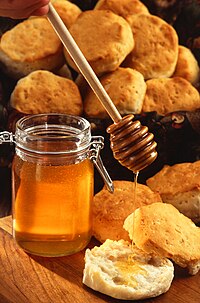
Photo from wikipedia
Natural substances are increasingly being developed for use in health-related applications. Honey has attracted significant interest, not only for its physical and chemical properties, but also for its antibacterial activity.… Click to show full abstract
Natural substances are increasingly being developed for use in health-related applications. Honey has attracted significant interest, not only for its physical and chemical properties, but also for its antibacterial activity. For the first time, suspensions of Black Forest honeydew honey and manuka honey UMF 20+ were examined for their antibacterial properties against Escherichia coli and Staphylococcus epidermidis using flow cytometry. The inhibitory effect of honey on bacterial growth was evident at concentrations of 10, 20 and 30 v/v%. The minimum inhibitory effects of both honey types against each bacterium were also investigated and reported. Electrospray ionisation (ESI) mass spectrometry was performed on both Black Forest honeydew honey and manuka honey UMF 20+. Manuka honey had a gluconic concentration of 2519 mg/kg, whilst Black Forest honeydew honey had a concentration of 2195 mg/kg. Manuka honey demonstrated the strongest potency when compared to Black Forest honeydew honey; therefore, it was incorporated into nanofiber scaffolds using pressurised gyration and 10, 20 and 30 v/v% manuka honey-polycaprolactone solutions. Composite fibres were analysed for their morphology and topography using scanning electron microscopy. The average fibre diameter of the manuka honey-polycaprolactone scaffolds was found to range from 437 to 815 nm. The antibacterial activity of the 30 v/v% scaffolds was studied using S. epidermidis. Strong antibacterial activity was observed with a bacterial reduction rate of over 90%. The results show that honey composite fibres formed using pressurised gyration can be considered a natural therapeutic agent for various medicinal purposes, including wound-healing applications.
Journal Title: Polymers
Year Published: 2022
Link to full text (if available)
Share on Social Media: Sign Up to like & get
recommendations!